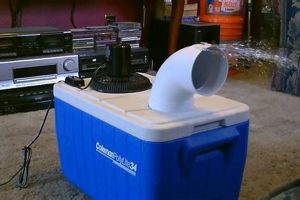A self-constructed device for dispensing feed to swine allows for controlled and efficient provision of sustenance. Such constructions typically involve readily available materials and basic tools, enabling livestock owners to manage feeding schedules and minimize waste. Examples include repurposed barrels, modified troughs, and gravity-fed systems built from plastic containers.
The creation and utilization of these devices offer several advantages, including cost savings through the use of recycled materials and reduced feed spillage. Historically, agricultural communities have employed inventive methods for livestock care, adapting available resources to meet their specific needs. These adaptations contribute to sustainable farming practices and efficient resource management.
The following discussion will explore various designs and construction techniques, considering material selection, structural integrity, and suitability for different herd sizes and feeding strategies. An examination of safety considerations and best practices for long-term use will also be presented.
Construction Guidance
The subsequent guidelines offer insights into building an effective and safe feeding apparatus for swine.
Tip 1: Material Selection. Prioritize durable, non-toxic materials resistant to weather and animal damage. Untreated wood may degrade quickly, whereas certain plastics could leach harmful chemicals. Steel drums or food-grade plastic containers are frequently employed options.
Tip 2: Secure Construction. Ensure all joints and connections are robust. Bolted or welded assemblies are preferable to relying solely on adhesives, particularly when constructing larger units intended to withstand significant weight and force.
Tip 3: Weather Protection. Incorporate features to shield feed from rain and sun. A sloped roof or overhanging lip can prevent spoilage and maintain feed quality. Drainage holes should be included to prevent water accumulation within the feeder.
Tip 4: Accessibility. Design the unit to accommodate the size and number of animals. Adequate feeding space prevents aggression and ensures all swine have equal access to the provisions. Consider adjustable height settings to accommodate growing pigs.
Tip 5: Pest Control. Implement strategies to minimize access by rodents and birds. A tightly sealed design and regular cleaning prevent infestation and reduce feed loss. Elevated platforms can also deter smaller animals.
Tip 6: Safety Measures. Eliminate sharp edges or protruding hardware that could cause injury. Reinforce potentially weak points to prevent collapse or tipping. Anchor the structure to the ground if necessary to prevent it from being overturned.
Tip 7: Regular Maintenance. Implement a schedule for routine inspections and repairs. Promptly address any signs of wear or damage to ensure the feeder remains functional and safe for animal use. Cleaning the interior periodically will further prevent feed spoilage.
Adhering to these principles will contribute to a lasting and efficient feeding solution. Careful planning and construction are essential for ensuring the well-being of livestock.
The following section will address specific design considerations and case studies related to feeding apparatus construction.
1. Material Durability
The longevity and effectiveness of a self-constructed swine feeding apparatus hinge critically on the selected construction materials. Material durability, therefore, represents a foundational aspect in the design and implementation of such systems, directly impacting maintenance requirements, replacement frequency, and overall cost-effectiveness.
- Resistance to Physical Damage
Swine are powerful animals capable of inflicting significant damage to structures. Materials chosen for feeding apparatus construction must withstand constant rubbing, pushing, and potential impacts. For example, a thin plastic feeder will likely crack and fail quickly under stress, while a feeder constructed from heavy-gauge steel will exhibit far greater resilience. Proper design using adequate materials is necessary for effectiveness of the feeder.
- Environmental Degradation Mitigation
Outdoor feeding stations are exposed to a range of environmental factors, including rain, sun, and temperature fluctuations. Materials prone to rust, rot, or UV degradation will require frequent repair or replacement. Pressure-treated lumber, galvanized steel, and UV-resistant plastics are examples of materials selected to mitigate these effects, extending the feeder’s lifespan and reducing the need for constant upkeep. Choosing an improper material can result in failure of the product.
- Corrosion Prevention
Contact with feed and animal waste can accelerate corrosion in certain materials. Steel, unless properly coated or treated, is particularly susceptible to rust. Aluminum and certain types of plastic offer better corrosion resistance. Careful selection of corrosion-resistant materials is essential for maintaining structural integrity and preventing contamination of the feed. Proper selection is necessary for animal care.
- Longevity and Life Cycle Cost
While initial material costs may be a primary consideration, long-term durability directly influences the overall life cycle cost of a self-constructed feeder. A more expensive, but durable, material will likely prove more cost-effective in the long run by reducing maintenance, repair, and replacement expenses. Balancing initial cost with long-term performance is therefore crucial in material selection.
The selection of robust and appropriate construction materials is paramount for ensuring the long-term functionality and cost-effectiveness of a self-constructed swine feeding apparatus. Attention to factors such as physical damage resistance, environmental degradation mitigation, and corrosion prevention will ultimately determine the success and lifespan of the feeding solution.
2. Capacity adequacy
The successful implementation of a self-constructed swine feeding device hinges on capacity adequacy, which directly influences the efficiency and effectiveness of the feeding process. Insufficient capacity leads to competition among animals, unequal access to feed, and potentially, stunted growth in weaker individuals. Conversely, an excessively large capacity can result in feed spoilage and wasted resources. Capacity must be carefully calculated based on the number of animals, their age, and their individual feeding requirements. A small-scale operation with a few piglets requires a drastically different design than a large-scale farm with mature hogs. For instance, a repurposed 55-gallon drum, while a common material for feeder construction, may only be suitable for a small number of animals, necessitating mult
iple feeders or a larger capacity design for larger herds. Capacity, therefore, is a main component in the overall design.
The practical significance of understanding the relationship between animal needs and feeder capacity extends to feed management and cost control. Overfilling a feeder leads to spillage and waste, attracting pests and increasing feed costs. Underfilling the feeder results in underfed animals and reduced productivity. Monitoring feed consumption patterns and adjusting capacity accordingly is crucial. Real-world examples demonstrate this principle: farms that meticulously track feed usage per animal and adjust feeder capacity accordingly report significantly reduced feed waste and improved animal growth rates. This demonstrates the importance of appropriate device size and capability.
In conclusion, capacity adequacy is an indispensable consideration in the design and utilization of self-constructed swine feeding devices. The challenges associated with insufficient or excessive capacity underscore the necessity for accurate needs assessment and careful design implementation. The successful integration of appropriate capacity contributes significantly to efficient resource utilization, improved animal welfare, and enhanced overall farm productivity. The appropriate ability can contribute to a better result.
3. Waste minimization
The construction and employment of a self-made swine feeding apparatus presents a tangible opportunity for waste minimization. Feed waste in swine operations constitutes a significant economic drain and environmental concern. A well-designed feeder, constructed to precise specifications, directly mitigates spillage, reduces spoilage due to weather exposure, and limits access by non-target species, thereby preserving feed resources. Examples include designs incorporating inward-sloping troughs to prevent hogs from throwing feed out, and covered hoppers to protect feed from rain and sun. These features directly address the cause-and-effect relationship between feeder design and waste volume.
The practical significance of waste reduction extends beyond economic benefits. Minimizing feed waste reduces the environmental impact associated with feed production, including land use, water consumption, and greenhouse gas emissions. A concrete example is a farmer who implemented a self-built feeder with adjustable feed flow rates, enabling precise rationing based on animal age and weight. This adjustment resulted in a documented 15% reduction in feed waste compared to previous feeding methods. Furthermore, reducing spillage minimizes the attraction of rodents and birds, reducing the risk of disease transmission within the swine herd.
Ultimately, waste minimization is an integral component of sustainable swine farming practices. Thoughtful construction of a feeding device, tailored to specific herd sizes and feeding regimens, offers a cost-effective and environmentally responsible approach to resource management. Challenges remain in adapting designs to diverse farm environments and ensuring consistent construction quality, but the potential benefits justify the effort. Addressing waste reduction through self-constructed feeding solutions aligns with broader goals of efficient resource utilization and sustainable agricultural production.
4. Weather resistance
Exposure to the elements directly impacts the functionality and longevity of any self-constructed swine feeding apparatus. Inadequate weather resistance results in feed spoilage, structural degradation, and increased maintenance requirements. Rain penetration leads to mold growth and feed clumping, rendering it unpalatable and potentially harmful to the animals. Direct sunlight degrades certain materials, causing cracking and weakening. Temperature fluctuations induce expansion and contraction, compromising structural integrity over time. Therefore, a properly constructed feeding device must incorporate design elements specifically addressing these challenges.
Practical applications of weather-resistant design principles are numerous. A simple example is the inclusion of a sloped roof over the feeding trough, deflecting rainwater away from the feed. Elevated feeders prevent ground moisture from wicking into the feed supply. The selection of water-resistant materials, such as treated lumber or specific plastics, is essential. Furthermore, drainage holes located in the base of the feeder prevent the accumulation of standing water. The absence of such features significantly reduces the lifespan of the apparatus and increases the likelihood of feed spoilage. One can also select materials that hold up to the UV rays of the sun. This prevents the material from breaking down over time and prevents cracking.
In summary, weather resistance is a critical component of any durable feeding apparatus. Ignoring this aspect results in reduced feed quality, increased waste, and a shortened lifespan of the structure. Careful consideration of materials, design features, and environmental factors ensures a more effective and cost-efficient feeding solution for swine operations. Over-engineering and a strong selection of materials is a key step to success for weather resistance.
5. Animal safety
Animal safety is a paramount concern in the construction and utilization of any self-made swine feeding apparatus. The inherent interaction between swine and the feeding device presents numerous opportunities for potential injury. Sharp edges, protruding hardware, unstable structures, and toxic materials pose direct threats to animal welfare. Neglecting these safety considerations can result in lacerations, infections, fractures, poisoning, and, in severe cases, mortality. A poorly designed feeder, therefore, becomes a liability rather than an asset. For example, the use of unsecured metal sheeting can create sharp edges that cause injury as animals attempt to access feed. This type of danger can be avoided with careful planning.
The practical significance of prioritizing animal safety in feeder construction extends beyond ethical considerations. Injured animals experience reduced growth rates, increased susceptibility to disease, and diminished overall productivity. Veterinary intervention and treatment costs associated with preventable injuries contribute to significant economic losses. Furthermore, poorly designed feeders can create stress and aggression within the herd as animals compete for access to feed. Real-world examples illustrate the importance of these factors: farms that implement strict safety protocols in feeder construction experience lower rates of animal injury and improved overall herd health. Proper design for safety is essential to success.
In summary, animal safety is not merely an ancillary concern but rather a fundamental requirement in the design and implementation of self-constructed swine feeding devices. The challenges associated with preventing injury underscore the necessity for meticulous planning, careful material selection, and adherence to established safety guidelines. The successful integration of safety considerations contributes significantly to animal welfare, reduces economic losses, and promotes sustainable farming practices. The design and construction of feeding devices require an adherence to general a
nimal safety requirements. This adherence improves overall health and well-being.
6. Pest control
The design and implementation of a self-constructed swine feeding apparatus necessitates careful consideration of pest control measures. The ready availability of feed attracts various pests, including rodents, birds, and insects, creating a nexus of potential problems. These pests consume and contaminate the feed, resulting in economic losses and the spread of diseases. A poorly designed feeder exacerbates this issue, providing easy access and harborage for unwanted organisms. Therefore, pest control is not merely an ancillary concern but an integral component of a well-functioning feeding system. Failure to address pest control results in feed waste, increased disease risk, and diminished overall productivity. One common method involves raising the feeder off the ground, making it more difficult for rodents to access. A secure lid further prevents access by birds and other small animals.
Practical applications of pest control principles in feeder design are multifaceted. The construction of tight-fitting lids prevents access by birds and rodents. Elevating the feeder reduces access for ground-dwelling pests. The use of smooth, non-porous materials minimizes harborage for insects. Additionally, the implementation of regular cleaning protocols removes spilled feed and potential nesting sites. Real-world examples demonstrate the effectiveness of these strategies: farms employing feeders with secure lids and regular cleaning schedules report significantly lower pest infestations and reduced feed losses compared to farms utilizing open or poorly maintained feeders. Regular cleaning is a simple and effective action.
In conclusion, effective pest control is critical for maintaining the integrity and efficiency of a self-constructed swine feeding apparatus. The challenges associated with pest infestations underscore the necessity for proactive design considerations and consistent maintenance practices. Successfully integrating pest control measures minimizes feed waste, reduces disease transmission, and contributes to a more sustainable and profitable swine farming operation. Vigilance and preventative measures are central to maintaining a pest-free feeding environment.
7. Cost efficiency
The creation and deployment of a self-constructed swine feeding apparatus offers a direct pathway to enhanced cost efficiency within livestock operations. The financial benefits stem from multiple sources, including reduced capital expenditures, minimized feed waste, and decreased labor requirements. Purchasing commercially manufactured feeders represents a significant initial investment. Constructing a feeding device using readily available or repurposed materials substantially lowers this upfront cost. This differential in initial expenditure allows resources to be allocated to other areas of the farm. For example, a farmer might utilize reclaimed lumber and discarded metal barrels to construct a feeder, avoiding the cost of purchasing a new commercial unit. The reduced capital investment directly translates into improved cost efficiency.
The connection between a self-made feeding device and cost savings extends beyond initial investment. A well-designed unit minimizes feed waste through controlled dispensing mechanisms and protective features that prevent spoilage. By reducing waste, the amount of feed purchased is lowered, directly impacting operational costs. Furthermore, a self-constructed feeder can be customized to specific farm needs, optimizing its functionality and minimizing the need for costly modifications or adjustments. An example is a feeder with adjustable feed flow rates, tailored to the specific needs of different age groups of swine, minimizing waste and maximizing feed utilization. Finally, a well-designed self-made apparatus will reduce the amount of human labor required.
In summary, the concept and creation of a feeding device, constructed in an independent manner, aligns directly with the goal of improving cost efficiency in swine farming. The reduced initial investment, minimized feed waste, and potential for optimized functionality all contribute to a more profitable and sustainable operation. While challenges exist in ensuring consistent construction quality and adapting designs to diverse farm environments, the potential economic benefits underscore the value of self-constructed feeding solutions. These devices allow the farm to operate efficiently and effectively.
Frequently Asked Questions
The following section addresses common inquiries regarding the design, construction, and utilization of self-constructed swine feeding devices.
Question 1: What materials are most suitable for constructing a durable feeding apparatus?
Materials should be selected based on their resistance to physical damage, environmental degradation, and corrosion. Common options include treated lumber, galvanized steel, and food-grade plastic. Untreated wood is susceptible to rot, while non-food-grade plastics may leach harmful chemicals.
Question 2: How does one determine the appropriate capacity for a feeding device?
Capacity should be determined by considering the number of animals, their age, and their average daily feed consumption. Overcrowding at the feeder leads to competition and unequal access to feed. Conversely, excessive capacity results in feed spoilage and waste.
Question 3: What design features minimize feed waste?
Features such as inward-sloping troughs, covered hoppers, and adjustable feed flow rates contribute to reduced feed waste. These features prevent spillage, protect feed from weather exposure, and allow for controlled dispensing based on animal needs.
Question 4: How can a self-constructed feeder be made more weather-resistant?
Weather resistance is enhanced through the incorporation of sloped roofs, elevated platforms, and drainage holes. These features protect feed from rain, snow, and ground moisture. Material selection also plays a crucial role.
Question 5: What safety precautions should be taken during construction and use?
Safety precautions include eliminating sharp edges, securing all connections, and anchoring the structure to prevent tipping. Non-toxic materials should be used to avoid poisoning. Regular inspections and maintenance are essential for identifying and addressing potential hazards.
Question 6: How can pest infestations be prevented in and around the feeding apparatus?
Pest infestations are minimized through the use of tight-fitting lids, elevated platforms, and regular cleaning. These measures restrict access to feed and eliminate potential nesting sites for rodents, birds, and insects.
In summary, the successful implementation of a self-constructed swine feeding apparatus requires careful attention to material selection, capacity planning, waste minimization, weather resistance, safety, and pest control.
The subsequent section will delve into specific design considerations and case studies related to feeding apparatus construction.
diy hog feeder
This exposition has explored the multifaceted considerations surrounding “diy hog feeder” design and implementation. It has elucidated the critical roles of material durability, capacity adeq
uacy, waste minimization, weather resistance, animal safety, pest control, and cost efficiency. The successful integration of these elements dictates the long-term functionality and economic viability of any self-constructed swine feeding solution. These factors need to be carefully weighed and balanced against each other.
Effective management of these systems, a long-term commitment to ongoing maintenance and adaptation is a must. While the construction of a device provides a viable pathway to resourcefulness in swine operations, it demands due diligence to ensure animal well-being, environmental responsibility, and overall operational sustainability. Therefore, farmers are encouraged to thoroughly investigate each possible element before deployment.







